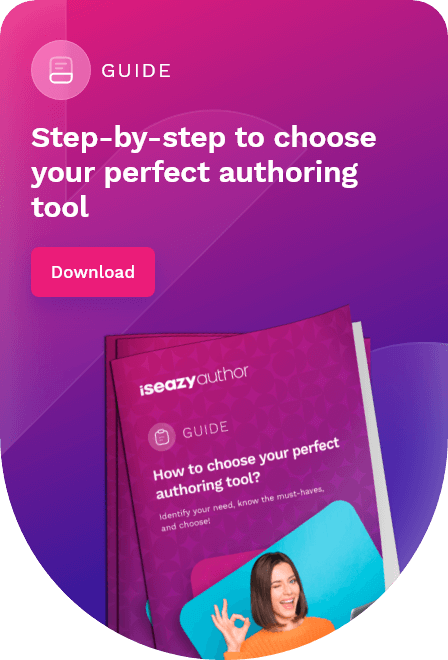Table of contents
ToggleIn the world of e-learning, accessibility is key to creating an inclusive and enriching experience for all learners, whether they are school or university students, or corporate employees. Unfortunately, it is estimated that only 20% of online training programs are actually accessible by this definition, underscoring just how important it is to address this challenge.
Many authoring tool providers claim that the content created with their products is accessible, but is that really true? In this article, we invite you to reflect on this question, and demand true accessibility in the tools you choose to use. Find out why it’s important to ask the right questions, and ensure your provider meets those all-important accessibility standards and regulations.
The consequences of using an inaccessible authoring tool
Before you start developing accessible e-learning content, it’s important to consider the consequences of using an authoring tool that doesn’t fully comply with accessibility standards. Here are some of them:
1. False compliance
An author might believe that their tool meets accessibility criteria based on information provided by their provider, only to discover that it only meets basic criteria, such as providing alternative text for images or increasing font size. The end result is courses that are not truly accessible and don’t meet accessibility standards.
2. Digital exclusion
An authoring tool that does not offer accessibility options can lead to the digital exclusion of people with disabilities. This means that such learners will be unable to fully participate in e-learning activities, limiting their training and excluding them from equal opportunities in education.
3. Loss of opportunities
Another consequence of using an authoring tool that lacks true accessibility is the loss of opportunities for work, education, or participation in projects important to people with disabilities. This limits the personal and professional growth of everyone within a company, and negatively affects their quality of life.
4. Risk of legal non-compliance
In many countries, there are laws and regulations that require courses to be accessible to people with disabilities. If your authoring tool is not capable of creating training programs that meet these requirements, you may face serious legal action or other penalties.
What accessibility norms and standards should I know?
In order to evaluate the true accessibility of an authoring tool, it’s crucial to be familiar with internationally established norms and standards, such as the WCAG (Web Content Accessibility Guidelines). These guidelines define the requirements for web accessibility at three different conformance levels: A, AA and AAA.
- WCAG A: The basic conformance level that establishes the minimum guidelines for web accessibility. It includes about 25 criteria.
- WCAG AA: The intermediate conformance level that establishes broader and more detailed guidelines for web accessibility. Includes approximately 50 to 60 criteria.
- WCAG AAA: The advanced compliance level that establishes the most rigorous and detailed guidelines for web accessibility. It includes about 75 to 100 criteria.
It is important to remember that the exact number of criteria may vary and evolve with updates to the WCAG guidelines. Ask your provider if their tool has been designed to create content whose accessibility can be evaluated and certified according to these standards.
Automated accessibility audits: Do they really work?
Although automated audits are useful as a starting point, they are not sufficient to guarantee true accessibility. It’s essential to have accessibility experts conduct manual audits to assess technical aspects required by compliance levels.
Also, keep in mind that tools like those offered by Google can mistakenly label content as accessible when it’s not. Therefore, it’s important that your provider offers a comprehensive accessibility solution that includes manual testing, instead of relying solely on automated tools to certify accessibility.
To make it even easier for you, below we provide a brief comparison of the most popular authoring tools on the market so you can check whether they meet some of the WCAG guidelines or not.
How do you know if your authoring tool is truly accessible?
A vendor committed to accessibility should be transparent with its clients and provide tangible evidence of their authoring tool’s accessibility. One way to evaluate accessibility standards is through the VPAT (Voluntary Product Accessibility Template).
Check if your provider has an up-to-date VPAT. If most of the items are marked with terms like “Support through equivalent Facilitation,” “Support with Exceptions,” “Not applicable,” or “Supports when combined with Compatible AT,” it means that the tool doesn’t fully meet accessibility standards on its own. Responsibility for making the course accessible falls on the course creator and third-party tools not included.
Ensure accessibility in your e-learning content with isEazy Author
In conclusion, before accepting superficial claims about an authoring tool’s accessibility, evaluate if it truly complies with established standards and guidelines.
Remember that accessibility goes beyond changing contrast or increasing font size; it involves providing equal opportunities for all your professionals. Therefore, demand transparency, evidence, and compliance with accessibility standards from your provider.
With isEazy Author, you can create courses that meet 100% of AA criteria and 80% of AAA criteria of WCAG automatically, without being an expert. Create your content without worrying about color limitations, fonts, or interactivity. All our elements adapt intelligently to be accessible, and your learners can use it in their preferred mode: accessible or non-accessible.
Want to learn more about accessibility in isEazy Author? Press play to watch!














